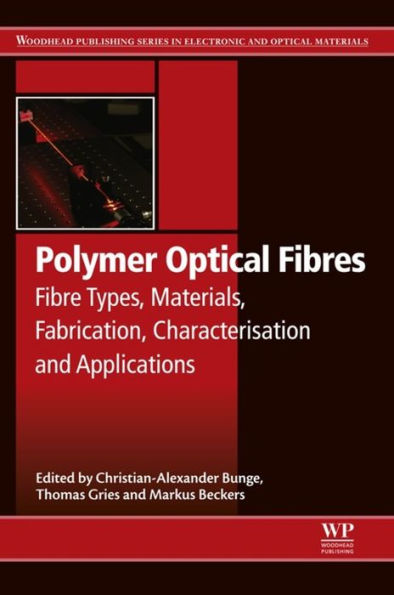Polymer Optical Fibres: Fibre Types, Materials, Fabrication, Characterization, and Applications explores polymer optical fibers, specifically their materials, fabrication, characterization, measurement techniques, and applications. Optical effects, including light propagation, degrading effects of attenuation, scattering, and dispersion, are explained. Other important parameters like mechanical strength, operating temperatures, and processability are also described. Polymer optical fibers (POF) have a number of advantages over glass fibers, such as low cost, flexibility, low weight, electromagnetic immunity, good bandwidth, simple installation, and mechanical stability.
- Provides systematic and comprehensive coverage of materials, fabrication, properties, measurement techniques, and applications of POF
- Focuses on industry needs in communication, illumination and sensors, the automotive industry, and medical and biotechnology
- Features input from leading experts in POF technology, with experience spanning optoelectronics, polymer, and textiles
- Explains optical effects, including light propagation, degrading effects of attenuation, scattering, and dispersion
Polymer Optical Fibres: Fibre Types, Materials, Fabrication, Characterization, and Applications explores polymer optical fibers, specifically their materials, fabrication, characterization, measurement techniques, and applications. Optical effects, including light propagation, degrading effects of attenuation, scattering, and dispersion, are explained. Other important parameters like mechanical strength, operating temperatures, and processability are also described. Polymer optical fibers (POF) have a number of advantages over glass fibers, such as low cost, flexibility, low weight, electromagnetic immunity, good bandwidth, simple installation, and mechanical stability.
- Provides systematic and comprehensive coverage of materials, fabrication, properties, measurement techniques, and applications of POF
- Focuses on industry needs in communication, illumination and sensors, the automotive industry, and medical and biotechnology
- Features input from leading experts in POF technology, with experience spanning optoelectronics, polymer, and textiles
- Explains optical effects, including light propagation, degrading effects of attenuation, scattering, and dispersion

Polymer Optical Fibres: Fibre Types, Materials, Fabrication, Characterisation and Applications
436
Polymer Optical Fibres: Fibre Types, Materials, Fabrication, Characterisation and Applications
436eBook
Related collections and offers

Product Details
| ISBN-13: | 9780081000564 |
|---|---|
| Publisher: | Elsevier Science |
| Publication date: | 08/25/2016 |
| Series: | Woodhead Publishing Series in Electronic and Optical Materials |
| Sold by: | Barnes & Noble |
| Format: | eBook |
| Pages: | 436 |
| File size: | 101 MB |
| Note: | This product may take a few minutes to download. |
